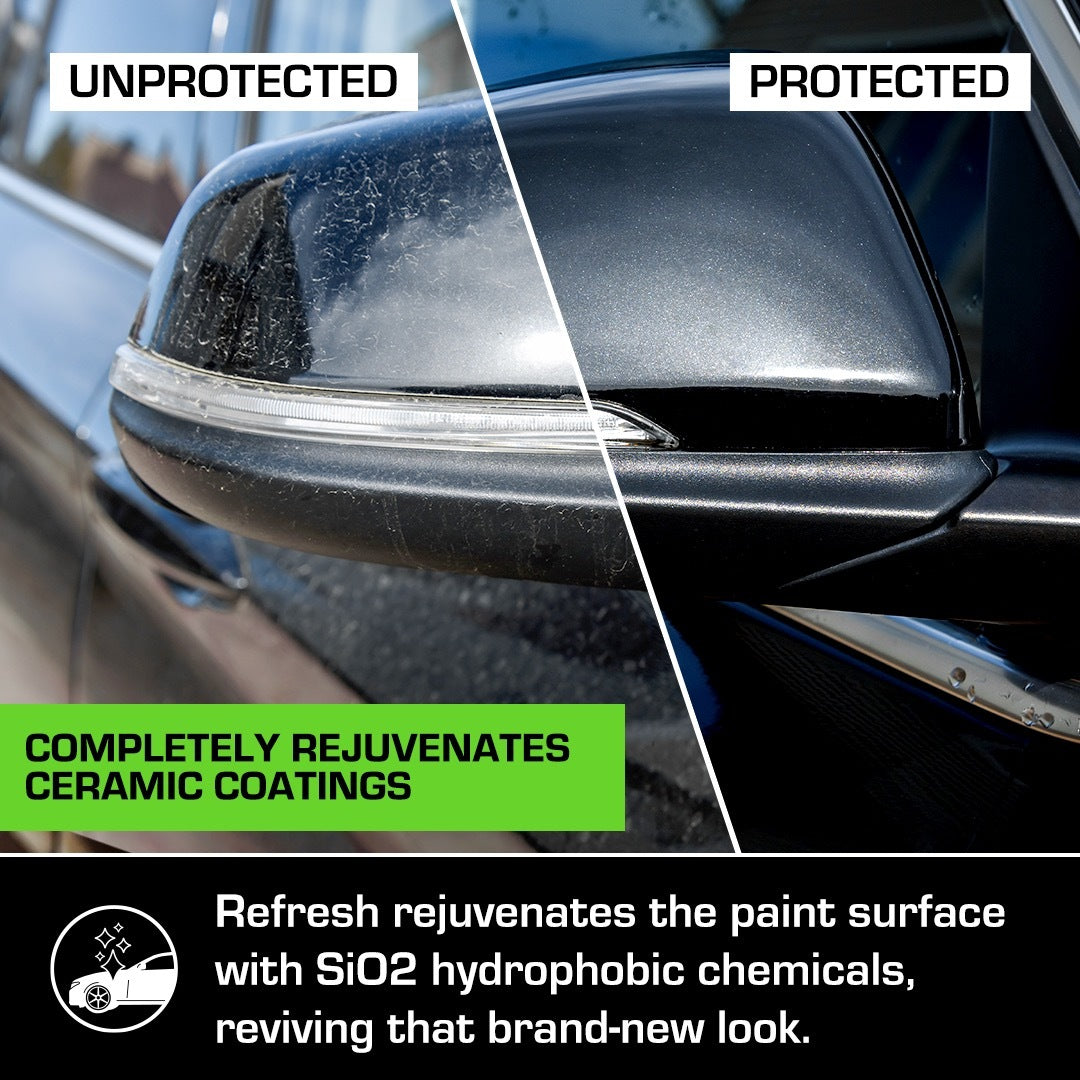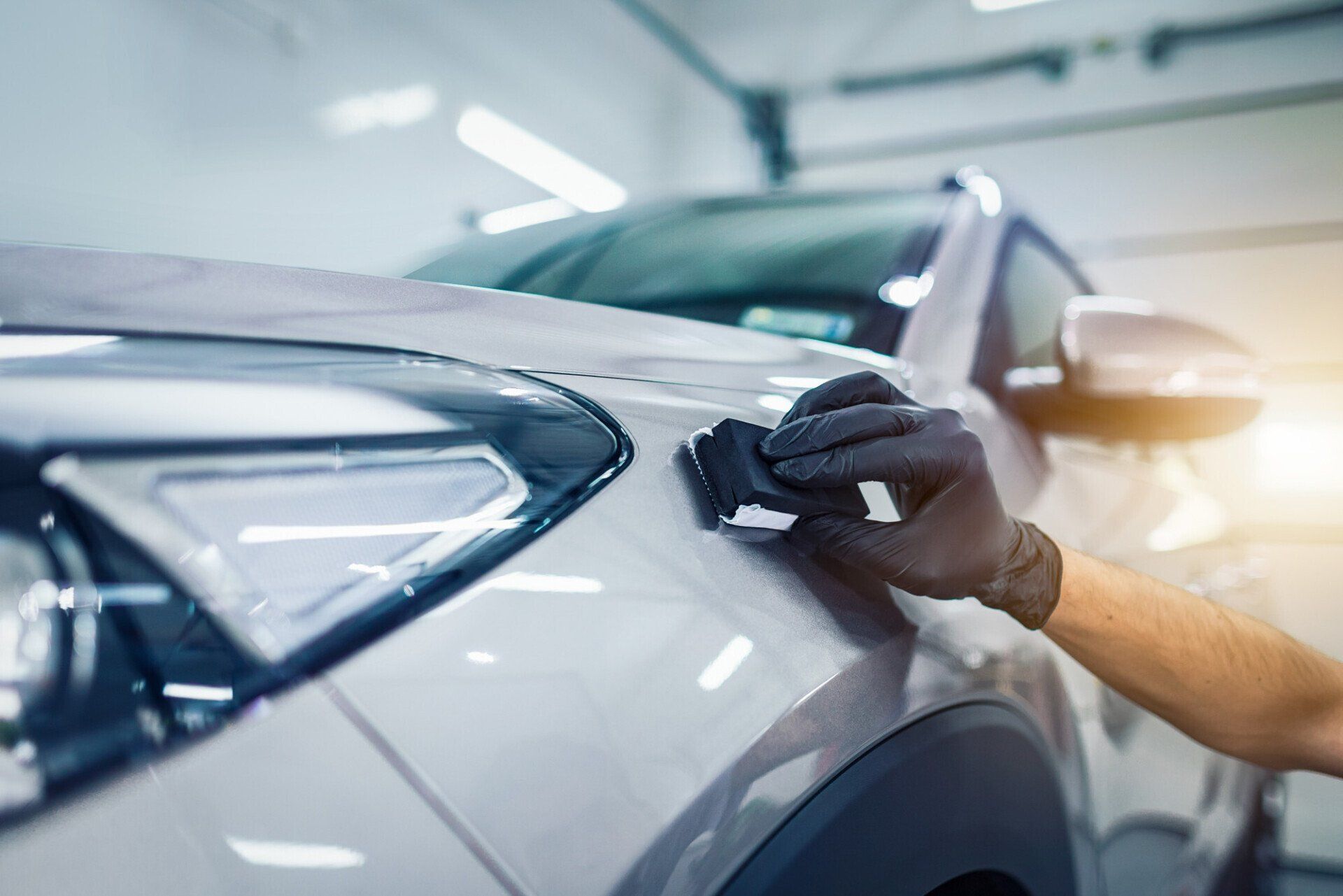Checking out the Science Behind Car Ceramic Coating and Its Safety Properties
The scientific research of car ceramic coating provides an interesting research study in sophisticated automobile security. Composed mainly of silicon dioxide and polymers, these finishings form a robust bond with lorry paint. This interaction improves sturdiness against environmental hazards while supplying hydrophobic benefits. The ins and outs of just how these finishes job and their long-lasting advantages continue to be less recognized. Ceramic Coating Newark. Unboxing these details exposes why ceramic finishings are becoming a favored selection for vehicle treatment
What Is Ceramic Coating?
Ceramic coating is a liquid polymer that chemically bonds to the surface of a lorry's paint. This sophisticated protective layer boosts toughness and provides remarkable resistance to environmental factors. Unlike traditional wax or sealers, which offer momentary security, ceramic coatings produce a resilient guard that can stand up to extreme problems such as UV rays, acidic impurities, and severe climate. When applied correctly, the coating develops a hydrophobic surface, triggering water to grain and slide off, which helps in maintaining the automobile's tidiness. Additionally, it uses improved gloss and depth to the paint, making the car show up more polished and vivid. The application procedure usually involves thorough surface area prep work, including cleansing and sprucing up, to guarantee peak bonding. As a result, ceramic coatings are ending up being significantly preferred among car enthusiasts and those looking for to safeguard their financial investments, assuring to keep the lorry's aesthetic charm while minimizing the regularity of maintenance.
The Make-up of Ceramic Coatings
The elaborate formulation of ceramic layers largely includes silicon dioxide (SiO2), which is originated from natural sources like quartz and sand. This key part gives the foundation for the coating's toughness and safety top qualities. In enhancement to SiO2, ceramic finishings typically include various polymers and ingredients that enhance bond, flexibility, and resistance to ecological elements. These compounds work synergistically to develop a robust barrier versus impurities such as dust, chemicals, and UV rays.Furthermore, some formulas integrate titanium dioxide (TiO2) or other nanomaterials, which can enhance the coating's hydrophobic residential or commercial properties, resulting in improved water repellency. The exact composition can vary significantly amongst manufacturers, influencing efficiency and long life. Ultimately, the combination of these elements culminates in a protective layer that not only enhances the aesthetic charm of vehicles however likewise serves to extend their life expectancy by protecting the surface from potential damage.
Just How Ceramic Coatings Job
Recognizing just how ceramic coatings function includes exploring their chemical structure, which adds to their safety top qualities. The application procedure is necessary for attaining suitable results, while long life and resilience factors figure out the coating's effectiveness over time. Together, these elements highlight the benefits and performance of ceramic finishings for vehicle security.
Chemical Structure Explained
While several car owners look for lasting defense for their cars, the chemical composition of ceramic coatings plays a crucial duty in their efficiency. These coverings mostly contain silicon dioxide (SiO2), which is originated from natural minerals. This substance forms a strong bond with the automobile's paint, creating a sturdy, protective layer. Additionally, lots of ceramic layers contain titanium dioxide (TiO2), enhancing their hydrophobic properties and resistance to UV rays. The existence of polysiloxanes can even more enhance adaptability and toughness. With each other, these components contribute to the coating's capability to drive away water, dust, and pollutants, while additionally providing a high-gloss surface. Comprehending this chemical structure assists car owners appreciate the durable security used by ceramic finishings.
Application Refine Introduction
Using ceramic finishings involves a meticulous process that ensures perfect bonding and protection for the automobile's surface area. Originally, thorough cleaning and purification of the car's outside are carried out to eliminate dirt, grime, and previous waxes. This step verifies that the surface area is without pollutants that could hinder bond. Following this, the paint is frequently brightened to enhance quality and get rid of any kind of flaws. As soon as prepared, the ceramic coating is used in tiny areas utilizing an applicator pad, permitting consistent coverage. The coating is then delegated heal, developing a solid chemical bond with the surface. Appropriate curing times and problems are vital, as they confirm the coating accomplishes its maximum effectiveness and protective qualities.
Long Life and Resilience Factors
Ceramic coverings are developed to give resilient security via their advanced chemical composition, which creates a durable barrier against environmental pollutants. The toughness of these finishes is affected by aspects such as the density of the application, the high quality of the product, and the conditions under which the car is revealed. Top notch ceramic layers can last numerous years, withstanding scratches, UV rays, and chemical discolorations. Proper upkeep, consisting of normal washing and routine reapplication, can further boost longevity. Additionally, environmental variables like climate and exposure to pollutants can influence the life expectancy of the coating. On the whole, when applied and maintained correctly, ceramic coverings use outstanding longevity, making them a popular selection for car lovers looking for to protect their automobile's appearance.
Hydrophobic Properties and Water Repellency
Hydrophobic residential properties are a characteristic of quality car ceramic finishings, significantly boosting the car's surface efficiency. These finishings create a molecular bond with the car's paint, resulting in a surface that fends off water effectively. When water comes into call linked here with a ceramic-coated surface area, it beads up and rolls off, decreasing the quantity of fluid that continues to be on the paint. This actions not just adds to an aesthetically pleasing appearance but also reduces the accumulation of impurities such as dust, crud, and roadway salts.The boosted water repellency leads learn this here now to much easier cleaning and upkeep, as much less effort is required to get rid of undesirable materials. Furthermore, the hydrophobic nature of ceramic coatings assists in preventing water spots, which can mar the surface of uncoated surface areas. In general, the unification of hydrophobic properties in ceramic finishings plays a vital function in keeping the automobile's excellent appearance while simplifying upkeep.
Protection Versus Scratches and UV Damages
Car ceramic coatings supply substantial security versus scrapes and UV damage. The scrape resistance mechanism produces a long lasting layer that absorbs impacts, while the UV protecting advantages assist keep the car's paint integrity gradually. Together, these attributes add to a longer-lasting and aesthetically appealing surface.
Damage Resistance Device
Utilizing sophisticated innovation, ceramic coatings provide a robust shield versus scratches and UV damage, boosting the durability and appearance of automobile surfaces. The scratch resistance mechanism of these finishings is attributed to their one-of-a-kind molecular framework, which develops a long lasting bond with the car's paint. This bond produces a hard, safety layer that can take in effects and stand up to abrasions. Furthermore, the smooth surface of the coating minimizes rubbing, making it hard for impurities to stick and trigger scrapes. The chemical make-up of ceramic finishings often includes nanoparticles that enhance the protective layer, further improving its strength. Consequently, lorries treated with ceramic finishes display markedly improved scratch resistance contrasted to traditional wax or sealants, guaranteeing a beautiful finish in time.
UV Protecting Conveniences
The safety qualities of ceramic layers expand past scratch resistance to find out this here include substantial UV shielding benefits. These layers produce a robust barrier that shows unsafe ultraviolet rays, safeguarding the lorry's paint and underlying products. Extended exposure to UV radiation can lead to fading, oxidation, and degeneration of the paint coating. By including ceramic finishes, automobile owners can successfully mitigate these risks, maintaining the visual charm and integrity of their autos. In addition, the UV obstructing homes add to improved longevity, reducing the regularity of repainting and maintenance. Inevitably, the combination of ceramic coatings supplies a detailed option for protecting vehicles from the destructive results of sunlight exposure, guaranteeing a sustained, lively appearance in time.
The Long life and Maintenance of Ceramic Coatings

Often Asked Inquiries
Can Porcelain Coating Be Applied to Any Type Of Kind Of Automobile?
Ceramic coating can be put on different sorts of automobiles, including autos, vehicles, and bikes. Nonetheless, surface area prep work and compatibility with specific products are important for optimal attachment and effectiveness of the coating.
Just How Much Does Ceramic Coating Normally Expense?
Ceramic coating normally sets you back between $500 and $2,000, depending on factors such as vehicle dimension, coating top quality, and expert application. The investment can give resilient protection and boost the car's look over time.

Is Professional Application Necessary for Ideal Outcomes?
The requirement of expert application commonly depends upon preferred results. Experts normally ensure correct surface area preparation and application techniques, bring about excellent bonding and long life of the coating, which may be testing for unskilled individuals to accomplish.
Can Porcelain Coatings Be Eliminated or Repaired?
Ceramic layers can be gotten rid of or repaired, though the procedure may require details solvents or methods - Ceramic Coating Newark. Proper removal is important to prevent damage to the underlying surface, emphasizing the value of professional assistance for ideal outcomes
How Does Ceramic Coating Contrast to Conventional Wax?
The contrast between ceramic coating and typical wax exposes that ceramic finishings offer premium toughness, enhanced security versus environmental impurities, and longer-lasting shine, while wax calls for much more constant application and provides much less total resistance to damage.